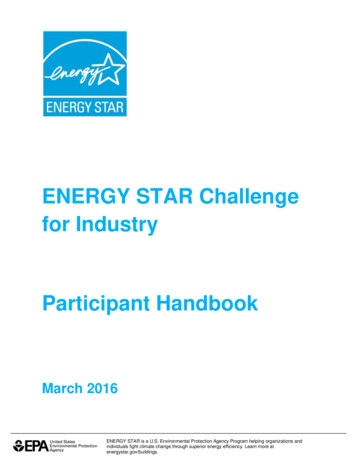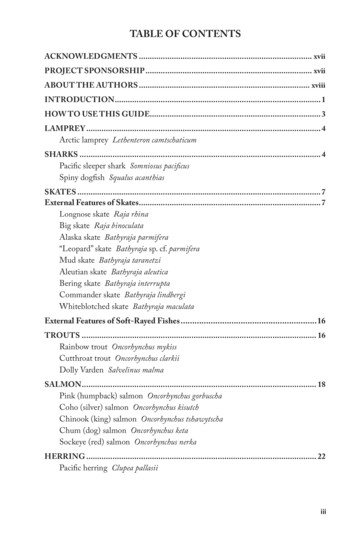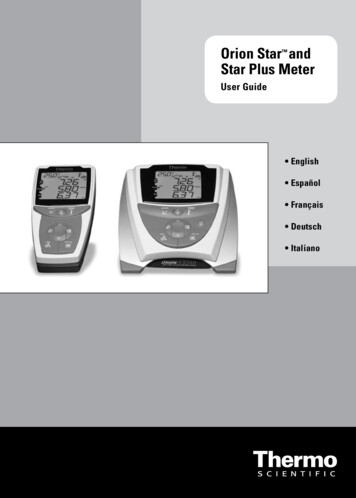
Transcription
ENERGY STAR Challengefor IndustryParticipant HandbookMarch 2016ENERGY STAR is a U.S. Environmental Protection Agency Program helping organizations andindividuals fight climate change through superior energy efficiency. Learn more atenergystar.gov/buildings.
ContentsOverview . 3Participation Eligibility. 4How to Participate . 5Step 1:Establish an energy intensity metric . 5Step 2:Select an energy tracking method . 6Step 3:Set a baseline and 10 percent improvement goal . 6Step 4:Create a formal site file and plan for tracking data . 7Step 5:Register for the Challenge . 8Step 6:Track energy use and achieve the 10 percent reduction . 8Step 7:Verify energy savings and apply for recognition . 9Contact Information . 10U.S. EPA Review of ENERGY STAR Challenge for Industry Recognition Application . 11Continuing the Commitment . 11Appendix 1. ENERGY STAR Tools and Resources Referenced in this Handbook . 13Appendix 2. Formal Site File . 14Appendix 3. Selecting an Energy Intensity Metric . 172
OverviewThe U.S. Environmental Protection Agency’s (EPA) ENERGY STAR Challenge forIndustry is a tool designed to help energy managers and industrial sites improve siteenergy performance and set goals. Industrial sites participate by committing to the preestablished goal of reducing energy intensity by 10 percent within 5 years or less.There are good reasons to participate. Industrial sites: Create momentum for energy initiatives bysetting an improvement goal; Establish energy management practices fortracking and benchmarking energy performanceto produce results; Leverage ENERGY STAR, the most recognizedname in energy efficiency, to motivate sites;and, Demonstrate a commitment to protect theenvironment by pledging to improve energyperformance.Industrial sitescommit to the goalof reducing energyintensity by 10percent within 5years or less.Any industrial site can take the ENERGY STAR Challenge for Industry. Companies areencouraged to promote this tool among their industrial sites worldwide.Participation is easy. Sites follow these seven steps.1.2.3.4.5.6.7.Establish an energy intensity metric;Select an energy tracking method;Set a baseline and 10 percent improvement goal;Create a formal site file and plan for tracking data;Register for the Challenge;Track energy use and achieve the 10 percent reduction; and,Verify energy savings and apply for recognition.Recognition of good work motivates better performance. U.S. EPA recognition1includes: An official certificate from the ENERGY STAR program documenting savings; The opportunity to be profiled on the ENERGY STAR web site; A congratulatory letter from U.S. EPA to the company’s CEO highlighting thesite’s accomplishments; and, Materials for communicating the site’s achievement within the organization.1To be recognized by U.S. EPA, a site’s parent company must be an ENERGY STAR partner.3
Participation EligibilityAn industrial site must meet the following requirements. A site’s primary activity mustbe classified within one of the following North American Industrial Classification System(NAICS) codes. Manufacturing (NAICS codes 31-33) – The site must be engaged in themechanical, physical, or chemical transformation of materials, substances, orcomponents into new products. The assembling of component parts ofmanufactured products is considered manufacturing, except in cases where theactivity is appropriately classified as construction. Mining, Quarrying, and Oil and Gas Extraction (NAICS codes 21) – The sitemust be engaged in extracting naturally occurring mineral solids, such as coaland ores; liquid minerals, such as crude petroleum; and gases, such as naturalgas. Agriculture, Forestry, Fishing and Hunting (NAICS codes 11) – The site mustbe engaged in growing crops, raising animals, harvesting timber, and harvestingfish and other animals from a farm, ranch, or their natural habitats.A site with mixed uses (such as those which include research and development,administration, and manufacturing) may participate in the ENERGY STAR Challenge forIndustry as long as the manufacturing and research and development energy usemakes up 50 percent or more of the site’s total energy use. Otherwise, the site isineligible to participate. Research and development space, for the purposes of theChallenge for Industry, includes laboratories, vivariums, clean rooms, product testinglabs, and other areas requiring ventilation rates much higher than typical office andadministrative spaces.Mixed-use sites are not required to sub-meter to distinguish between industrial and nonindustrial spaces but should be able to provide an estimate of the energy loads or usefor each space type.A site may be located anywhere in the world. For sites outside of the U.S. or itsterritories, the parent company must be an ENERGY STAR partner and operateindustrial sites within the U.S. or its territories.4
How to ParticipateTo participate in the ENERGY STAR Challenge for Industry, sites follow these basicsteps.Locations of all forms and tools referenced in this handbook are identified in Appendix1.Step 1:Establish an energy intensity metricAn energy intensity metric must be used to track progress toward meeting the 10percent reduction goal at each site. The energy intensity metric may be set in terms ofenergy per unit of production or energy per square footage of the site, depending uponthe energy load of the site (i.e., how and where energy is used).The metric must capture the energy use intensity of the whole site – not individualprocesses or energy sources – and must account for all forms of energy (e.g., solidfuels, electricity, gases, etc.). All energy must be expressed in British Thermal Units(BTUs), and converted from “site” energy to “source” energy.2The site’s energy load determines the proper type of metric to use. If 60 percent or more of the site’s energy load is directly linked to industrialprocesses, then the metric must reflect a measure of production (e.g.,BTU/pound of product). Sites are encouraged to use existing production-basedenergy intensity metrics as long as these meet the criteria. If 60 percent or more of the site’s energy load is due to non-production processutility systems (e.g., lighting, heating, and cooling), then the metric must reflect ameasure of the building (i.e., BTU/square footage). Sites using a building metricare encouraged to use ENERGY STAR’s Portfolio Manager, which normalizesfor building area and weather. For sites with energy loads not meeting either of these criteria, a metric may bedeveloped that is representative of the site's operations. When a nonproduction/square footage metric is used, a rationale must be provided in theChallenge for Industry Registration Form (Step 5).2“Site” energy is the amount of energy (including electricity) consumed at an industrial site. “Source”energy represents the total amount of raw fuel that is required to operate an industrial site andincorporates all transmission, delivery, and production losses, thereby enabling a complete assessmentof the energy efficiency of an industrial site. Energy may be delivered to a facility as primary and/orsecondary energy. For more information on converting “site” to “source” energy, see Appendix 3 of thishandbook, or see “Understanding Source and Site Energy” and use the Quick Converter tool on theENERGY STAR Web site.5
To learn more on how to develop an energy intensity metric for a site, please seeAppendix 3.Step 2:Select an energy tracking methodTo track energy over time, a system must be in place to ensure consistency. Sites usinga production-based energy intensity metric (e.g., BTU/pound of product) may use one ofthe following methods.1. An existing energy tracking system;2. The ENERGY STAR Energy Tracking Tool; or,3. An ENERGY STAR Plant Energy Performance Indicator, if one is available forthe specific site type.Sites using a building-based energy intensity metric may use U.S. EPA’s onlineENERGY STAR Portfolio Manager tool to track energy use, or another existing systemthat normalizes for weather. Within Portfolio Manager, sites must choose the spacetype category of “Other.”Sites that normalize using a multivariate energy intensity metric and statistical modelsare permitted to use these metrics and their existing tracking method as long as theycapture annual energy use. Such sites must provide a rationale when registering for theENERGY STAR Challenge for Industry and must indicate that their baseline, metric,and reduction goal are based on this method when applying for recognition.Step 3:Set a baseline and 10 percent improvement goalCalculating a change in energy intensity requires establishing a starting point formeasuring improvement, known as the baseline. The baseline must cover a full,consecutive twelve-month period (e.g., April 2014 through March 2015) prior toregistering for the ENERGY STAR Challenge for Industry, and represent the site’scorresponding energy intensity for that identified period.The baseline may be defined in several ways using one of the following methods. The immediate past calendar year (e.g., a site signing up in April 2016 could settheir baseline as January 1 – December 31, 2015), orAnother consecutive 12-month period such as the most recent 12 months (e.g., asite signing up in April 2016 could set their baseline as April 1, 2015 – March 31,2016), provided that the baseline end date is within 12 months of the date thebaseline is registered with EPA, or,The company’s most recent fiscal year.Note: Sites are encouraged to consider a baseline period consistent with theircompany’s energy data tracking cycle to make calculations convenient.6
To determine a site’s energy intensity for the baseline period, total the site’s sourceenergy use across the full twelve-month baseline period (Note that use of the ENERGYSTAR Quick Converter, found on the Challenge for Industry tools and resourceswebpage, and in the Statement of Energy Improvement workbook, is stronglyrecommended). If using a production-based metric (e.g., BTU/pound of product), dividethe total energy use by the total production of the same period. If using a buildingbased metric (e.g., BTU/square footage), divide the total energy use by the total of thatbuilding measurement. The result of either calculation is the average annual energyintensity for the baseline period.After the baseline is set, determine the energy intensity reduction needed to achieve the10 percent reduction goal. For example:Baseline annual energy intensity 500 BTU/pound of productImprovement goal 10%In this example a 10% reduction from the baseline of 500 BTU/pound of productis 50 BTU/pound of product. The resulting energy intensity reduction goal thatmust be achieved would be 50 less than the baseline of 500, which is 450BTU/pound of product.Intensity reduction required to meet the goal:500 BTU/pound of product x 10% 50 BTU/pound of productEnergy intensity reduction goal:500 BTU/pound of product – 50 BTU/pound of product 450 BTU/pound of productPlease note that the Statement of Energy Improvement – the official form used forshowing your achievement of the Challenge for Industry – requires that source MMBtufor Electricity and Thermal Energy be reported separately, so consider tracking bothelectricity and thermal components starting from the calculation of your baseline period.Step 4:Create a formal site file and plan for tracking dataSites participating in the ENERGY STAR Challenge for Industry are required toestablish a formal site file that includes all data used to participate in the ENERGYSTAR Challenge for Industry, and documents all data sources and assumptions. Thisfile must be kept at, or be accessible from, the site. In the case of sites located outsidethe continental U.S., a copy of the file must be kept with the corporate energy manager.The file may be physical or electronic, but must serve as a static, central repository of allrelevant information (e.g., emails discussing assumptions, baselines, etc. are copied tothe official file instead of residing in individual email boxes; data from a companydatabase are copied to the official file in a spreadsheet, screen shot, etc.). Thedocumentation included in this file must be sufficient whereby any person canunderstand the source of the data used. Appendix 2 discusses information that must be7
included in the formal site file. The formal site file is not submitted to U.S. EPA, but mustbe used by the Professional Engineer (PE) for verifying the site’s energy intensityreduction in Step 7.Tracking energy use over time requires some simple planning to assure accuracy.Sites may use the ENERGY STAR Challenge for Industry Energy Tracking PlanTemplate to create a basic plan to ensure proper data management and documentationif existing procedures or processes are not in place. The Energy Tracking Plan will helpyou record important details about the information that will be tracked through theENERGY STAR Challenge for Industry. This is especially important for assuring thatthe method of tracking each fuel type is consistent across the baseline and trackingperiods, including energy sources that are invoiced at irregular (non-monthly) intervals.The Energy Tracking Plan is an internal tool for the benefit of the site and does not needto be submitted to U.S. EPA. Sites also may use existing data management proceduresbut must confirm a procedure is in place upon registration.Step 5:Register for the ChallengeRegister online by completing the ENERGY STAR Challenge for IndustryRegistration Form.Step 6:Track energy use and achieve the 10 percent reductionTracking improvements in energy use begins immediately following the end of thebaseline period. As participating sites build or refine an energy program, completeprojects, and execute strategies to improve the site’s energy intensity, the impacts of allactions are measured through the tracking system. ENERGY STAR resources can helpa site improve! Find links in Appendix 1.The target energy intensity may be reached no earlier than 12 months from theconclusion of the baseline period.Annual reporting of progress is not required. A site submits a one-time report (theStatement of Energy Improvement) upon achieving the 10 percent energy intensityreduction and only if recognition is desired. This report will cover the entire trackingperiod, from the end of the baseline period through the end of the period for which the10 percent reduction is achieved. The 10 percent energy intensity reduction iscalculated for the final 12 months of the tracking period against the baseline period. If asite does not reach its goal within five years, there is no penalty to the site, and the sitemay re-register, if desired.8
Example Timeline for Baseline, Tracking, and RecognitionBaseline PeriodApril 1, 2015 –March 31, 2016Tracking PeriodApril 1, 2016 – until goal is achieved, but no later than March 31, 2021March 31, 2017: end of earliestperiod to apply for recognitionIn this example, the 10% reduction is achieved for a 12-monthperiod ending December 31, 2018 (shown by bracket). The entiretracking period (April 1, 2016 – December 31, 2018) will bereported, but only the final 12 months (January 1 – December 31,2018) will be used to calculate the intensity reduction in the FinalPeriod (see instructions in the Statement of Energy Improvement).Example Statement of Energy Improvement (Matching Above Timeline)Step 7:Verify energy savings and apply for recognitionAchieving a 10 percent energy intensity reduction is an important step forward inmanaging energy. To be recognized by U.S. EPA’s ENERGY STAR program, a site’s9
parent company must be an ENERGY STAR partner. Additionally, before recognition isprovided, U.S. EPA requires the site to verify that the savings were achieved.Sites applying for recognition must complete a Statement of Energy Improvement.The Statement of Energy Improvement provides the official documentation that the sitehas achieved the 10 percent energy intensity reduction. The Statement of EnergyImprovement is provided in a Microsoft Excel spreadsheet format and can bedownloaded from the ENERGY STAR web site. Applicants fill in the requiredinformation on the Statement of Energy Improvement and have it validated by a PE.The PE completing the verification process must indicate on the Statement of EnergyImprovement if the PE stamp is embossed.PE validation also ensures the accuracy and completeness of: Site physical characteristicsSite operating informationEnergy and related dataEnergy intensity reductionAvoided greenhouse gas emissions, if reportedFormal site fileThe PE must follow all instructions in the ENERGY STAR Challenge for IndustryProfessional Engineers’ Guide for Validating Statements of Energy Improvement.When the Statement of Energy Improvement has been validated, the site mustcomplete the online ENERGY STAR Challenge for Industry Recognition ApplicationForm and send copies of the validated Statement of Energy Improvement and PEVerification Checklist to U.S. EPA via email to industrychallenge@energystar.gov.Contact InformationFor questions regarding the U.S. EPA’s ENERGY STAR Challenge for Industry, refer tothe following links: E-mail: industrychallenge@energystar.gov Website: http://www.energystar.gov/industrychallenge10
U.S. EPA Review of ENERGY STAR Challenge for IndustryRecognition ApplicationUpon receipt of an application for recognition, U.S. EPA will review the RecognitionApplication Form, the validated Statement of Energy Improvement, and the PEVerification Checklist to determine if the site is eligible for ENERGY STAR Challenge forIndustry recognition.U.S. EPA follows this procedure.1. Review the application for completeness. Contact the applicant if anyinformation is missing.2. Confirm the site’s parent company is an ENERGY STAR partner.3. Verify that the baseline year and baseline intensity match those identified duringregistration. (Note: If the baseline or baseline intensity on the Statement ofEnergy Improvement do not match the baseline or baseline intensity provided toEPA during registration, an explanation for the difference must be noted in thePE Verification Checklist, accompanied by any necessary supportingdocumentation.)4. Verify that the 10 percent reduction goal was met within 5 years or less byreviewing the data contained in the Statement of Energy Improvement.5. Verify that the tracking period data in the Statement of Energy Improvementbegan immediately following the end date of the baseline period.6. Verify that the final 12-months of the tracking period during which the 10 percentenergy intensity reduction has been achieved ends at least 12 months after theconclusion of the baseline period.7. Verify that the application was submitted no later than four months from the endof the final 12 months of the tracking period during which the site achieved the 10percent energy intensity reduction.EPA also reserves the right to request and review any records used to calculate energyperformance. Therefore, the formal site file must be maintained for five years from theend date of the tracking period in which the 10 percent energy intensity reduction wasachieved.Continuing the CommitmentU.S. EPA is interested in the continual improvement of industrial site energy efficiency.U.S. EPA will recognize a site through the ENERGY STAR Challenge for Industry eachtime it reaches a 10 percent energy intensity reduction. For a site to continue itsparticipation in the ENERGY STAR Challenge for Industry, it must re-register by settinga new baseline. For a site immediately re-registering upon achievement of the 10percent energy intensity reduction, the baseline must be set as the most recent 12months of the tracking period during which the ENERGY STAR Challenge for Industrywas achieved. Sites not re-registering immediately must follow the instructions as if the11
site were a new participant in the ENERGY STAR Challenge for Industry. In no case,however, may a site that has previously achieved the Challenge for Industry set a newbaseline that precedes the latest achievement period.12
Appendix 1. ENERGY STAR Tools and ResourcesReferenced in this HandbookThese tools are available at www.energystar.gov/industrychallenge.ENERGY STAR Challenge for Industry Recognition Application FormENERGY STAR Challenge for Industry Registration FormENERGY STAR Challenge for Industry Statement of Energy ImprovementENERGY STAR Challenge for Industry Energy Tracking Plan TemplateENERGY STAR Energy Tracking ToolENERGY STAR Plant Energy Performance IndicatorsENERGY STAR Portfolio ManagerENERGY STAR Challenge for Industry Professional Engineers’ Guide for ValidatingStatements of Energy ImprovementENERGY STAR Quick ConverterOther ENERGY STAR tools and resources that can help you improve energyperformance are available at www.energystar.gov/industry.13
Appendix 2. Formal Site FileThe formal site file is defined as the centralized repository of ALL materials related to asite that has achieved the ENERGY STAR Challenge for Industry. The file may bephysical (e.g., a three-ring binder), electronic (e.g., a specific “folder” or directory savedon a corporate file server), or some combination. It is important that all information iscompiled in a centrally accessible location so that the site contact or corporate energymanager has immediate access to the formal site file upon the PE verification process.For example, emails exchanged within the company or with U.S. EPA during theapplication process would be archived to the formal site file, not maintained in thecorporate energy manager’s email box. Centralizing all information helps assure thatthe formal site file would not be lost when personnel change jobs.The formal site file is a stand-alone, self-explanatory file. All source material,assumptions, communications, etc., are documented such that anyone reviewing the filewould not need the site contact or corporate energy manager to explain why or how anyaspect was executed.The formal site file contains all information submitted to U.S. EPA as part of theENERGY STAR Challenge for Industry recognition application. This includes theoriginal PE-validated Statement of Energy Improvement, and copies of anycommunications exchanged with U.S. EPA regarding questions and clarifications toENERGY STAR Challenge for Industry (e.g., emails discussing assumptions, baselines,etc. are copied to the official file instead of residing in individual email boxes; data froma company database are copied to the official file in a spreadsheet, screen shot, etc.). Itwill also include the original PE Verification Checklist completed at the conclusion of PEverification.The formal site file contains all non-data background information supporting the site’seligibility to participate in the ENERGY STAR Challenge for Industry and receiverecognition. This includes:o All documentation supporting that the site meets the definition of an industrialsite.o All documentation supporting the accuracy of the site’s physical characteristicsand any other site-specific information required on the Statement of EnergyImprovement (e.g., site name, location, parent company information, and contactnames) matches that of the site applying for the ENERGY STAR Challenge forIndustry recognition.o All documentation showing U.S. EPA’s approval of the registered energyintensity metric and baseline.14
o Documentation showing an Energy Tracking Plan or existing data managementprocedures were in place during the duration of the site’s participation in theENERGY STAR Challenge for Industry.The formal site file contains all data underlying the numbers required on the Statementof Energy Improvement. This means:o All documentation supporting the non-energy operating characteristics used tocalculate the site’s energy intensity metric and all documentation that this metriccaptures the production or square footage for the whole site.o All documentation supporting the energy consumption used to calculate the site’senergy intensity metric and all documentation that this metric captures energy forthe whole site.o All documentation proving that the data used to track the energy performance isfrom the site named on the Statement of Energy Improvement.o For production-based energy metrics, all documentation supporting theproduction units used for calculating the energy intensity metric are consistentwith numbers from official company production records.o For building-based energy metrics, all documentation supporting the grosssquare footage of the site used for calculating the energy intensity metric areconsistent with company records.o For complex energy metrics, all documentation supporting that the approach wasapplied consistently during the tracking period and that the data used matchesthe source of the original normalized/multivariate data used to develop themetrics.o All documentation supporting that the production, gross square footage, and/ornormalized data used to calculate the energy intensity matches the data found inthe site’s energy tracking system, and that all data was tracked consistentlythroughout the duration of participating in the ENERGY STAR Challenge forIndustry.o All documentation supporting any other data used for normalization, ifnormalization was performed.o All documentation supporting that all data used reflects the whole facility and nota single process or individual part of the site.o All documentation supporting that all energy consumption for each energy sourceused to operate the facility and manufacturing processes (including purchasedand generated) was accounted for and reported in the Statement of EnergyImprovement.o If a site exports electricity or steam, all documentation showing that these exportshave been subtracted from the site’s total energy use.15
o Documentation/calculations showing that all forms of energy purchased and usedon site were properly converted to BTUs.o Documentation/calculations showing that all energy was properly converted from“site” to “source” energy, summed to Electricity and Thermal Energy categories,and reported on the Statement of Energy Improvement.o Documentation supporting that the baseline data entered into the Statement ofEnergy Improvement matches the baseline approved by U.S. EPA when the siteregistered to participate in the ENERGY STAR Challenge for Industry. If thebaseline or baseline intensity on the Statement of Energy Improvement do notmatch the baseline or baseline intensity provided to EPA during registration, anexplanation for the difference must be noted in the PE Verification Checklist,accompanied by any necessary supporting documentation.o All documentation supporting that the site reduced its energy intensity by at least10 percent within 5 years of the conclusion of the baseline period and all datawas accurately recorded.o All documentation that the tracking period began immediately following the enddate of the baseline period.o All documentation that the 12 months of the tracking period during which theenergy intensity reduction was achieved ends at least 12 months after theconclusion of the baseline period.o For sites choosing to report the avoided carbon dioxide equivalent (CO2e)emissions that are linked with the energy intensity reduction, all documentationsupporting that the estimates were calculated correctly using proper emissionfactors.16
Appendix 3. Selecting an Energy Intensity MetricEnergy intensity metrics can range from a simple ratio such as energy divided byproduction to complex multi-variant-based metrics calculated by algorithms. For theENERGY STAR Challenge for Industry, sites are allowed to choose their own metricand may be able to use an existing metric. Sites can use either a simple energyintensity metric or a complex one, depending on their needs.To participate in the ENERGY STAR Challenge for Industry, the energy intensity metricused to track performance must: Account for all fuel types (electric, thermal, etc.) used at the site in source BritishThermal Units (Btus);Energy Intensity Metric Reflect how energy is utilized in the plant through eithera production- or building-based measurement in themetric’s denominator; and Help the site effectively manage energy use.Numerator (energy) /Denominator (productionor building area)While sites are given flexibility to select their own metric, using a denominator based onrevenue, sales, or other monetary values that does not directly correspond with energyuse is discouraged, and may be approved only in rare circumstances.Sites are permitted to use a metric calculated from methods that normalize or control forspecific variables, such as weather, production volumes, or product mix. Sites using amulti-variant energy intensity metric will need to provide a short description of themethod used to calculate the metric when
Another consecutive 12-month period such as the most recent 12 months (e.g., a site signing up in April 2016 could set their baseline as April 1, 2015 - March 31, 2016), provided that the baseline end date is within 12 months of the date the baseline is registered with EPA, or, The company's most recent fiscal year.











